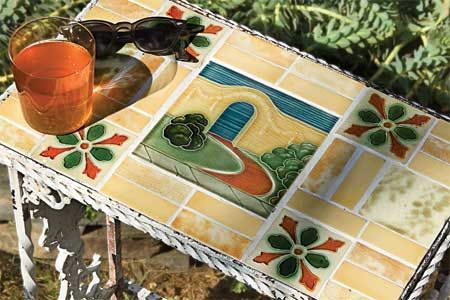 Wet tile saw
Wet tile saw Grout sponge
Grout sponge Plastic spreader
Plastic spreader Margin trowel
Margin trowel Sharpening stone
Sharpening stone Latex gloves
Latex gloves Safety glasses
Safety glasses
We may be compensated if you purchase through links on our website. Our team is committed to delivering honest, objective, and independent reviews on home products and services.
For centuries, decorative tiles have transformed the mundane elements of a house—namely floors and walls—into works of functional art. This Old House reader Rosi Zingales is a master at this type of disguise. In her submission to our online Salvage Challenge, she demonstrated how to turn a blah brick fireplace into a showpiece by decorating the hearth with swirls of vintage blue, white, and black tiles. The mosaic recalls the waves at the beach near her 1970s ranch house in Hampton Bays, New York. The front of her home’s concrete foundation is also completely covered in colorful tiles.
For this project, Zingales joined forces with This Old House antique salvage expert Amy R. Hughes to combine creativity and know-how with sleuthing for the right materials. In this guide, we’ll walk you through the process of designing and constructing your own vintage tile tabletop, from selecting materials to applying the finishing touches.
What Makes a Tile Tabletop “Vintage?”
A vintage tile tabletop typically features designs, patterns, or individual tiles that evoke a sense of nostalgia or reflect styles from past eras. These can include art deco patterns, Victorian-inspired motifs, or even salvaged tiles from historic buildings. The key is to create a look that appears aged or from a specific time, even if using new materials.
Crafting your own vintage tile tabletop allows for complete customization, ensuring your table perfectly matches your decor and personal style. Additionally, it’s often more cost-effective than purchasing a similar piece from an antique store. The process itself can be a fulfilling creative outlet, resulting in a conversation piece that tells a story and adds character to your space.
Gathering Materials and Tools for a Vintage Tabletop
Successful completion of your vintage tile tabletop project requires the right materials and tools.
Essential Tools for the Project
To create your vintage tile tabletop, you’ll need the following tools:
- A flat board the size of the tabletop
- Grindstone or tile file
- Grout sponge
- Latex gloves
- Margin trowel
- Pencil
- Plastic spreader
- Pressing weights (bricks, books, etc.)
- Rubber float tool or spatula
- Rubber scraper
- Safety glasses
- Sharpening stone
- Sponge
- Wet tile saw
These tools will help you cut tiles precisely, apply adhesive and grout effectively, and ensure your safety throughout the project.
Selecting the Right Tiles for a Vintage Look
Choosing tiles is perhaps the most crucial step in creating an authentic vintage look. Look for tiles with patterns, colors, or textures that reflect the era you’re aiming to emulate. Salvage yards, antique stores, and specialty tile shops are excellent sources for unique, period-appropriate tiles. Mix and match different styles for a more eclectic, vintage feel.
As for Zingales and Hughes, they rooted through the tile crates at Olde Good Things in New York City. Their key find was an 1890s 6-by-6-incher depicting a Spanish colonial mission. This, they agreed, would be the centerpiece. Next were four flowered accents and 30 yellow-and-white marbled tiles from an old fireplace surround that they bought in bulk.
Choosing the Right Grout Color
Select a grout color that complements your tiles and enhances the vintage look. Darker grouts can make light-colored tiles pop, while lighter grouts can brighten the overall appearance.
Choosing the Perfect Table Base
The table base is the foundation of your project. Look for a sturdy base with a recessed top to accommodate your tiled surface. Wrought iron bases often complement vintage tile designs well, but wooden bases can also work depending on your overall aesthetic goals. Zingales and Hughes used a wrought iron table with a recess for a glass top.
Other Materials
In addition to the tiles and base, here’s what you’ll need:
- 1/8-inch and 1/4-inch spacers
- Ceramic tile adhesive
- Grout
- Masonite board (optional)
- Polyvinyl glue (optional, to seal Masonite)
- Tile and grout sealant
Preparing Your Workspace and Materials for a Vintage Tile Tabletop
This project is as much about the journey as it is about the destination. Taking the time to set up your workspace and prepare your materials will lead to better results and a more enjoyable crafting experience.
Setting Up Your Work Area
Choose a well-ventilated area with plenty of space to lay out your materials. Cover your work surface with a protective material to prevent damage from adhesives or grout. Ensure you have good lighting to see the details of your tile work clearly.
Prepping the Table Base
If your table base has an existing surface, remove it carefully. Clean the base thoroughly and sand any rough spots. If the base has a recess for a glass top, this can be ideal for your tiled surface. Otherwise, you may need to create a level surface using a piece of 1/8-inch-thick Masonite board cut to fit the tabletop. If you use Masonite, be sure to seal it front and back with a polyvinyl glue like Weldbond. This will prevent it from absorbing the tile adhesive later.
Cleaning and Inspecting Your Tiles
Before starting your design, clean each tile thoroughly and inspect for any damage. This is especially important if you’re using salvaged or antique tiles. Set aside any damaged tiles for potential use in areas that require cut pieces.
Step 1: Designing Your Vintage Tile Pattern
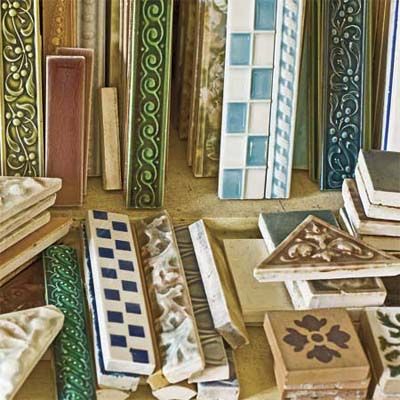
The design phase is where your creativity truly shines. Take time to experiment with different layouts to achieve the perfect vintage look for your tabletop.
Popular Vintage Tile Patterns
Some popular vintage tile patterns include the following:
- Bordered designs with a central focal point
- Checkerboard designs
- Floral motifs
- Geometric art deco patterns
- Mosaic layouts
Incorporating Focal Point Tiles
Focal point tiles can be the centerpiece of your vintage design. For Zingales and Hughes, this was the Spanish colonial mission tile. For you, focal points might be larger decorative tiles, tiles with unique patterns, or even small tile murals. Place these strategically to draw the eye and anchor your overall design.
Tips for Creating a Balanced Design
When designing your layout, aim for balance in color and pattern. Start by placing your focal point tiles, then build around them with complementary pieces. Consider mixing solid-colored tiles with patterned ones for added visual interest. Step back frequently to assess the overall look and make adjustments as needed.
Step 2: Laying Out and Cutting Tiles for a Vintage Tile Tabletop
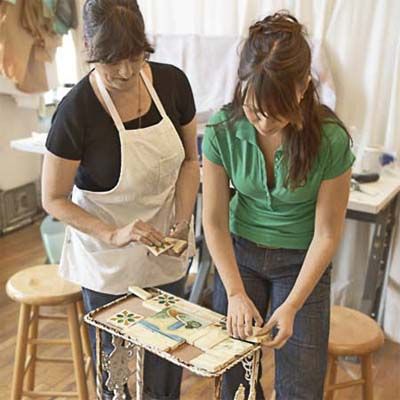
With your design planned, it’s time to start working with the tiles themselves. This stage requires precision and patience to ensure your final product matches your vision.
Dry Fitting Your Tile Design
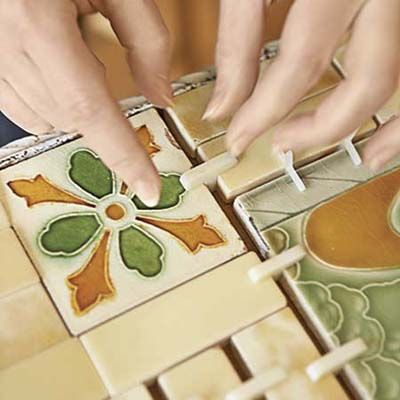
Begin by laying out your tiles on the tabletop or sealed Masonite board without adhesive. This dry fit allows you to make final adjustments to your design before committing. Use spacers between tiles to ensure consistent gaps for grouting later.
Marking Tiles for Cutting
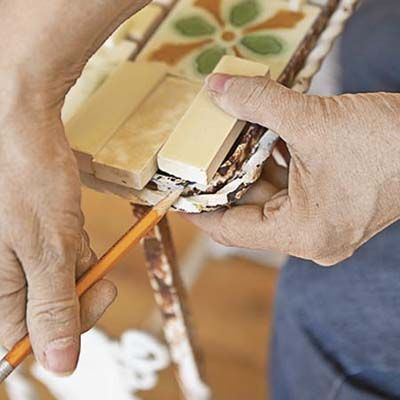
Once you’re satisfied with the layout, mark any tiles that you need to cut to fit the edges or around obstacles. Use a pencil to draw cutting lines on the back of the tiles, following the contours of your tabletop.
Using a Wet Saw for Precise Cuts
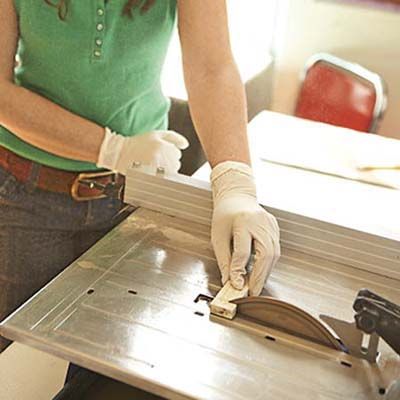
A wet saw is the best tool for making clean, precise cuts on ceramic or porcelain tiles. Always wear safety glasses and gloves when operating the saw. Follow the pencil lines you just made, taking your time with each cut to ensure accuracy and prevent chipping.
Pro tip: You can often fill small chips with color-matched epoxy. For cracked or severely damaged tiles, the best solution is usually to replace the affected tile entirely.
Smoothing Tile Edges
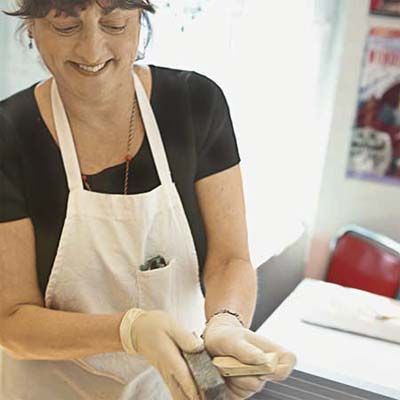
Some tiles may still have rough or jagged edges. Smooth these by hand with a grindstone (as seen above) or tile file. As you go, replace the tiles in your layout to ensure they fit. If there’s still a slight overlap, take off the excess with the grindstone.
Step 3: Adhering Tiles to Your Vintage Tabletop
With your tiles cut and ready, it’s time to permanently affix them to your tabletop.
Using Spacers for Even Gaps
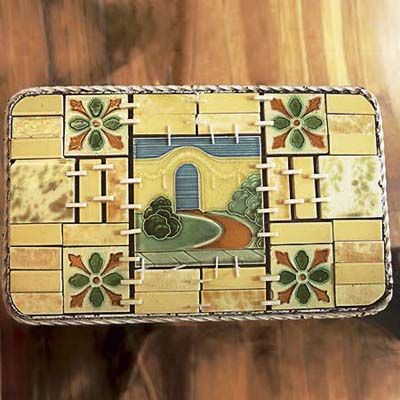
As you replace the tiles, insert tile spacers between tiles where you want to maintain consistent gaps for grouting. These spacers will help create a professional-looking finish and make the grouting process easier later on. Alternatively, for a more rustic handmade look, leave the spacers out. You can see the difference this makes on the dry-fit pattern above.
Applying Tile Adhesive
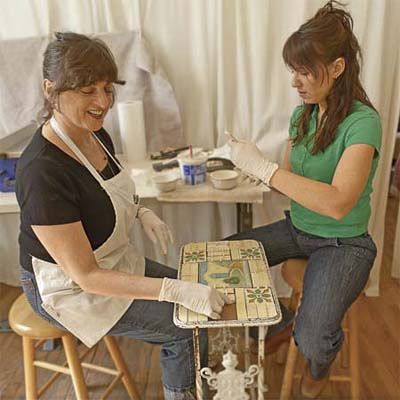
Choose a high-quality ceramic tile adhesive suitable for your tile type and tabletop material. Zingales and Huges used a thick mastic called Henry 314 which allowed them to build a bed under thin tiles to create a level surface.
Working from the center out, remove tiles one at a time, spread ceramic adhesive on their backs with a notched trowel, and then stick them on the board. Replace the spacers and let the adhesive set for 30 minutes, then remove them.
Pressing the Tiles
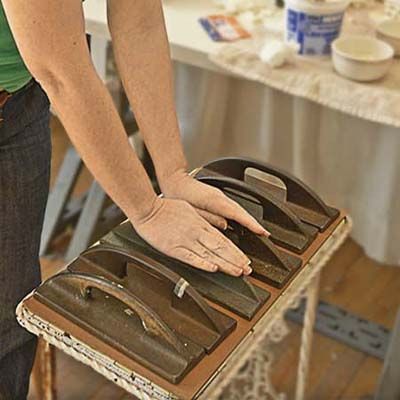
Position a flat board on top of the tiles, and weigh it down. Zingales used pattern weights from her costume shop (she makes clothes for theater and film), but bricks or heavy books will do. Wait 24 hours for the adhesive to dry before removing the weights
Step 4: Grouting and Finishing Your Tile Tabletop
Grouting is the final major step in creating your vintage tile tabletop. This process fills the gaps between tiles and gives your tabletop a polished, cohesive look.
Applying Grout Between Tiles
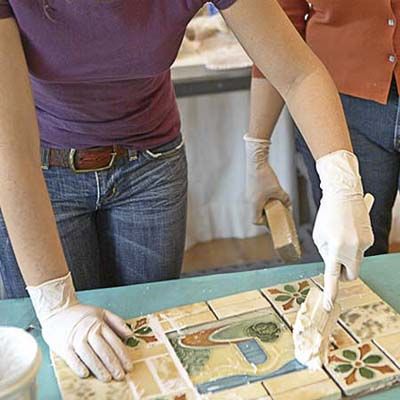
Mix your grout according to the manufacturer’s instructions. Use a sanded grout to fill gaps 1/8 of an inch or wider. Spread a thick coat of grout over the surface, and then work it into the gaps using a rubber float tool. Remove excess grout from the tile surfaces with a scraper and damp sponge.
Rosi’s Tip: “For small tile jobs, I use an old rubber spatula, instead of a trowel, to work the grout into tight spaces. It’s more flexible, and it spreads the grout like cake frosting.”
Cleaning and Sealing Your Finished Tabletop
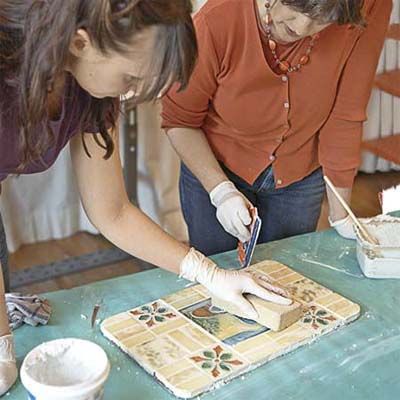
Once the grout has dried completely, clean any remaining haze from the tile surfaces with a soft cloth. Let the grout dry for 48 hours, then apply a tile and grout sealer to protect your work and make future cleaning easier. Allow the sealer to dry fully before using your new vintage tile tabletop.
Maintaining Your Vintage Tile Tabletop
Proper maintenance will keep your vintage tile tabletop looking beautiful for years to come. Below are some tips to keep in mind.
Regular Cleaning Techniques
Clean your tabletop regularly with a mild, pH-neutral cleaner and a soft cloth. Avoid abrasive cleaners or scrubbers that could damage the tile or grout.
Protecting Your Tabletop from Damage
Use coasters under glasses and placemats under dishes to prevent scratches and stains. This tabletop should be fine for occasional outdoor use, but always bring it in out of the rain or snow.
Consider applying a fresh coat of sealer annually to maintain protection. Over time, you may need to re-grout or replace damaged tiles as well. A restoration professional can help you with this if it becomes necessary.
